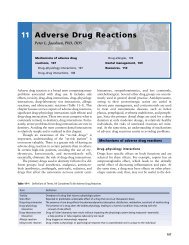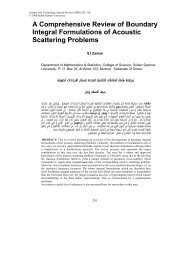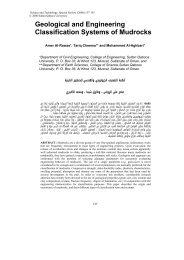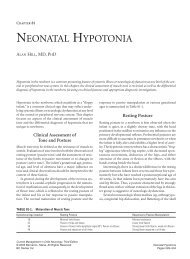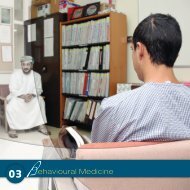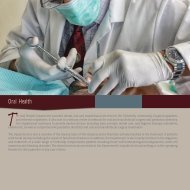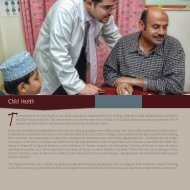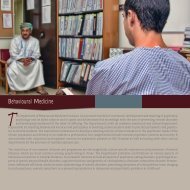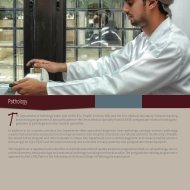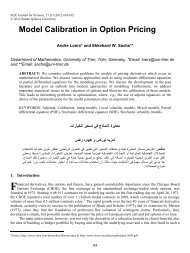Male Reproductive Toxicity - SQU Home
Male Reproductive Toxicity - SQU Home
Male Reproductive Toxicity - SQU Home
Create successful ePaper yourself
Turn your PDF publications into a flip-book with our unique Google optimized e-Paper software.
45. Niederberger, C. S., Lamb, D. J., Glinz, M., Lipshultz, L. I., and Scully, N. F., Tests of sperm function forevaluation of the male — Penetrak-Asterisk and Tru-Trax, Fertil. Steril., 60, 319–323, 1993.46. Biljan, M. M., Taylor, C. T., Manasse, P. R., Joughin, E. C., Kingsland, C. R., and Lewisjones, D. I.,Evaluation of different sperm function tests as screening methods for male fertilization potential — the valueof the sperm migration test, Fertil. Steril., 62, 591–598, 1994.47. Rogers, B. J., Use of SPA in assessing toxic effects on male fertilizing potential, Reprod. Toxicol., 2, 233–240,1988.48. Coddington, C. C., Franken, D. R., Burkman, L. J., Oosthuizen, W. T., Kruger, T., and Hodgen, G. D.,Functional aspects of human sperm binding to the zona-pellucida using the hemizona assay, J. Andrology,12, 1–8, 1991.49. Franken, D. R., Acosta, A. A., Kruger, T. F., Lombard, C. J., Ochninger, S., and Hodgen, G. D., Thehemizona assay — its role in identifying male factor infertility in assisted reproduction, Fertil. Steril., 59,1075–1080, 1993.50. Schrader, S. M., Turner, T. W., and Simon, S. D., Sources of variation of the sperm penetration assay underfield study conditions, Assist. Reprod. Technol. Androl., 2(Suppl. 4), 63–74, 1991.51. deGroat, W. C. and Booth, A. M., Physiology of male sexual function, Am. Intern. Med., 92, 329–331, 1980.52. Thomas, Jr., A. J., Ejaculatory dysfunction, Fertil. Steril., 39, 445–454, 1983.53. Krane, R. J., Goldstein, I., and de Tejada, I. S., Impotence, N. Engl. J. Med., 321, 1648–1659, 1989.54. Burris, A. S., Banks, S. M., and Sherins, R. J., Quantitative assessment of nocturnal penile tumescence andrigidity in normal men using a home monitor, J. Androl., 10, 492–497, 1989.55. Dixon, R. L., Sherins, R. J., and Lee, I. P., Assessment of environmental factors affecting male fertility,Environ. Health Perspec., 30, 53–68, 1979.56. Fabro, S., Ed., <strong>Reproductive</strong> Toxicology: A Medical Letter on Environmental Hazards to Reproduction, <strong>Reproductive</strong>Toxicology Center, Washington, D.C., 1985.57. Manson, J. and Simons, R., Influence of environmental agents on male reproductive failure, in Work and theHealth of Women, Hunt, V. R., Ed., CRC Press, Boca Raton, FL, 1979.58. Sever, L. E. and Hessol, N. A., Toxic effects of occupational and environmental chemicals on the testes, inEndocrine Toxicology, Thomas, J. A., Ed., Raven Press, New York, 1985.59. Thomas, J. A., <strong>Reproductive</strong> hazards and environmental chemicals: a review, Toxic Substances J., 2, 318–348,1981.60. American Fertility Society, What you should know about infertility, Contemp. Ob.-Gyn., 15, 101–105, 1980.61. Rantala, M. L., Epidemiological and Clinical Studies on the Etiology of Infertility, Dissertation, Universityof Helsinki, Finland, 1988.62. Purvis, K and Christiansen, E., <strong>Male</strong> infertility — current concepts, Ann. Med., 24, 259–272, 1992.63. Nelson, C. K. M. and Bunge, R. G., Semen analysis: evidence for changing parameters of male fertilitypotential, Fertil. Steril., 26, 503–507, 1974.64. Bostofte, E., Serup, J., and Rebbe, H., Has the fertility of Danish men declined through the years in termsof semen quality? A comparison of semen qualities between 1952 and 1972, Int. J. Fertil., l28, 91–95, 1983.65. Osser, O. Liedholm, P., and Ranstam, J., Depressed semen quality: a study over two decades, Arch. Androl.,12, 113–116, 1984.66. Menkveld, R., Van Zyl, J. A., Kotze, T. J. W., and Joubert, G., Possible changes in male fertility over 15-year period, Arch. Androl., 17, 143–144, 1986.67. James, W. H., Secular trends in reported sperm count, Andrologia, 12, 381–388, 1980.68. Carlsen, E., Giwercman, A., Keiding, N., and Skakkebaek, N. E., Evidence for decreasing quality of semenduring past 50 years, Br. Med. J., 305, 609–613, 1992.69. Kaur, S., Effect of environmental pollutants on human semen, Environ. Contam. Toxicol., 40, 102–104, 1988.70. Stachel, B., Daugherty, R. C., Lahl, U., Schlosser, M., and Zeschmer, B., Toxic environmental chemicals inhuman semen — analytical method and case studies, Andrologia, 21, 282–291, 1989.71. Gangi, G. R. and Nagler, H. M., Clinical evaluation of the subfertile man, Infertil. Reprod. Med. Clin. N.Am., 3, 299–318, 1992.72. Drife, J. O., The effects of drugs on sperm, Drugs, 33, 610–622, 1987.73. Whorton, D. and Foliart, D., DBCP: Eleven Years Later, NIOSH Symposium on the Assessment of <strong>Reproductive</strong>Hazards in the Workplace, Presentation June 16, Cincinnati, OH, 1988.74. Sas, M. and Szollosi, J., Impaired spermatogenesis as a common finding among professional drivers, Arch.Androl., 3, 57–60, 1979.75. Rosenberg, M. J., Wyrobek, A. J., Ratcliffe, J., Gordon, L. A., Watchmaker, G., Fox, S. H., Moore, II, D.H., and Hornung, R. W., Sperm as an indicator of reproductive risk among petroleum refinery workers, Br.J. Ind. Med., 42, 123–127, 1985.76. Potashnik, G., Carel, R., Belmaker, I., and Levine, M., Spermatogenesis and reproductive performancefollowing human accidental exposure to bromine vapor, Reprod. Toxicol., 6, 171–174, 1992.77. Birioukov, A., Meurer, M., Peter, R. U., Braun-Falco, O., and Plewig, G., <strong>Male</strong> reproductive system inpatients exposed to ionizing irradiation in the Chernobyl accident, Arch. Androl., 3, 99–104, 1993.© 1999 by CRC Press LLC





